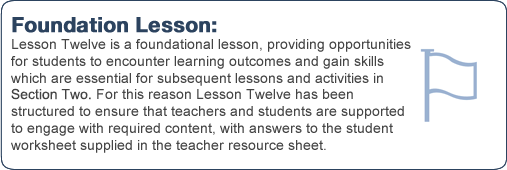Lesson 12: Making a budget
Introduction


Time:
Single class period
Materials:
Activity One: Design your own budget
- Flipchart sheets
- Markers
- Sample weekly budget
Homework Task:
- Sarah’s and John’s case studies
- Student Worksheet: Budget template
- Teacher Resource Sheet: Sample weekly budget
Introduction:
A budget is a plan of what you will do with your money. Making a budget is something that we all know we should do. Sometimes people don’t budget because they think that it is too complicated. In reality budgeting really is not all that difficult. It does take a bit of time but it is worth it! In this lesson students design their own weekly budget template, refer back to their spending diary and discover whether or not they are living within their means. Their homework task involves using case studies to populate a budget template, the correct answers for which are provided in a resource sheet for teachers.
Step-By-Step Instructions

Activity One: Design your own
1. Invite students to brainstorm what they learned about budgeting in Lesson 11.
2. Remind students that budgeting is a simple way to make sure that people can meet the demands of money going out.
3. Ask students if anyone has ever written down a budget? Maybe when they were on holidays or at Irish college, or if they were given a set amount of money for a set amount of time. What does the class think is the main advantage of a written budget?

4. Tell the class that they are going to work in small groups to create a template for a weekly budget. Each group will need to think about ways of recording INCOME (money coming in) and EXPENDITURE (money going out).

5. Divide the class into small groups and give each group a flipchart sheet and some markers.
6. Write the headings ‘MONEY COMING IN’ and ‘MONEY GOING OUT’ on the white/blackboard.
7. Take feedback from a sample of groups, recording what they say in relation to sources of income and items of expenditure under the appropriate heading on the white/blackboard.
8. Display the Sample weekly budget and encourage students to question anything they see, for example they may wonder why savings is included as ‘money out’. If so, explain that savings is money put aside to help you get things you want/need in the future. If you want to make sure you save something each week or month, record the amount as ‘money going out’. This means savings are a plan instead of an afterthought and this means they are ‘put away’.

9. Invite students to amend the Sample weekly budget to reflect the relevant income and expenditure categories suggested by student groups.
10. Conclude by making sure that students understand how to calculate total expenditure, total income and profit/shortfall.
Homework Task

Read through Sarah’s and John’s case studies, ensuring that everyone understands all the words/terms used. Depending on your group you may also wish to ensure that everyone knows that there are seven days in a week, four or five weeks in a month, and 52 weeks or 12 months in a year.
Invite students to choose either Sarah or John as their homework task. They should complete the Student Worksheet: Budget template using their chosen case study. On their worksheet students should record Sarah’s/John’s money coming in and the amount they have going out, then:
(A) Add up all the money Sarah/John has coming in.
(B) Add up all the money that Sarah/John has going out.
Subtract (B) from (A), i.e. subtract Sarah’s/John’s monthly expenditure from their monthly income.
The steps for reviewing this homework task are given at the start of Lesson 13.
Worksheets



